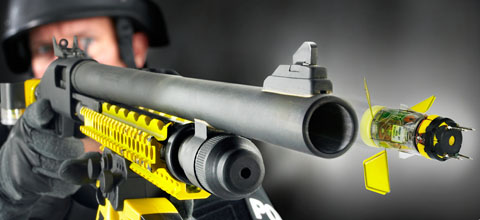SOURCE: DAVID WARD sayjaz3@hotmail.com
POSTED: 12 JUNE 2008 - 1:00pm EST
Taser Loses 1st Product-Liability Suit
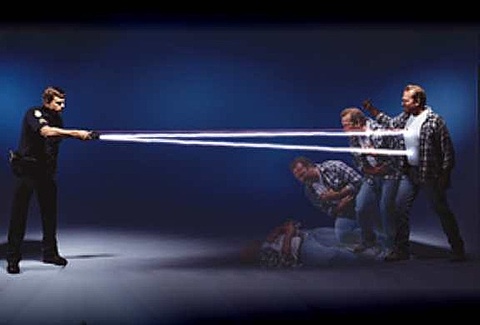
image above: Policeman can deliver deadly voltage to target's heart
| ;Jury Awards $6 Million By Margaret Cronin Fisk on 7 June 2008 in www.Bloomberg.com June 7 (Bloomberg) -- Taser International Inc., the largest stun-gun maker, lost a $6.2 million jury verdict over the death of a California man who died after police shot him multiple times with the weapon. The defeat is the first for Taser in a product- liability claim. A San Jose, California, jury yesterday said Taser had failed to warn police in Salinas, California, that prolonged exposure to electric shock from the device could cause a risk of cardiac arrest. The jury awarded $1 million in compensatory damages and $5.2 million in punitive damages to the estate of Robert Heston, 40, and his parents. The jury cleared the police officers of any liability. Taser previously won two trials, one over claims by a police officer injured in a training accident and the other involving a death in custody. Taser has settled at least 10 cases involving injuries to police officers during training, company lawyer Doug Klint told Bloomberg News last year. Taser said it will appeal the verdict. ``Certainly, this was a tragedy for the Heston family as well as for the officers involved,'' Klint said in a statement today. ``We, however, do not feel that the verdict is supported by the facts.'' Shot Multiple Times The compensatory damage verdict will be reduced by the jury's finding that Heston was 85 percent responsible for his death, said family attorney John Burton. `That affects the compensatory damages, but not the punitives,'' he said in an interview. ``I think Taser's going to have to rethink its litigation strategy and its warning policies,'' Burton said. The jury awarded $5 million in punitive damages to Heston's parents and $200,000 in punitives to his estate. Heston died on Feb. 20, 2005, after his father had called Salinas police because his son was ``acting strangely,'' and seemed to be on drugs, according to the lawsuit complaint. Salinas police shot Heston multiple times with the stun-gun, continuing to discharge their Tasers into him until he stopped moving, the lawsuit claims. Heston went into cardiac arrest and died, his family said. His parents sued Taser, alleging failure to warn of the dangers of the weapon, and Salinas police officers, claiming excessive force. The jury ``exonerated the police because they said the police didn't know repeated exposures could kill someone,'' Burton said. Use of the Taser on Heston didn't cause his death, Klint said. Heston fit ``the well established symptom pattern for methamphetamine intoxication and associated excited delirium,'' a condition linked to sudden death in custody, Klint said. The lawsuit is Heston v. City of Salinas, C 05-03658 JW, U.S. District Court, Northern District of California (San Jose). |
SOURCE: JUAN WILSON juanwilson@mac.com
POSTED: 10 MAY 2008 - 7:30pm HST
And you thought it was scary now?
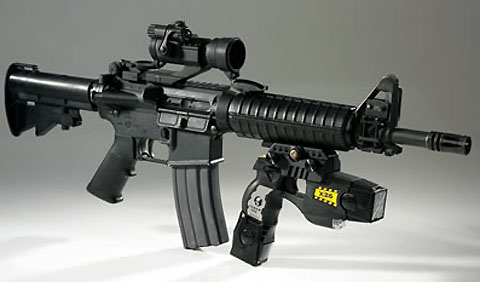
image above: Taser mounted on assault rifle. Just what every cop should carry in a crowd.
by Juan Wilson on 10 May 2008 "In Houston, deadly force against civilians is remaining the same, but excessive force is increasing wildly." - Peter Gorman in The Fort Worth Weekly The Kauai Police Department have no business buying assault rifles, riot shields, bulletproof vests or tasers. We do not need an armored mobile command center. This is not the police force this island wants. If Chief Darryl Perry wants an effective police force for Kauai he should be seeking the trust of the public and learn what kind of support they need. His job is not supporting the storm troopers or protecting the big mainland corporations screwing us over.
|
SOURCE: ANDREA BROWER andrea@malamakauai.org
POSTED: 10 MAY 2008 - 7:30pm HST
Cardiologist says studies on tasers flawed
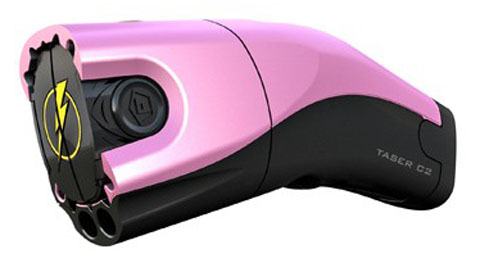
image above: The new pink purse-size personal electrocution device for milady
by Anna Mehler Paperny on 10 May 2008 in www.theglobeandmail.com
|
SOURCE: JUAN WILSON juanwilson@mac.com
POSTED: 10 MAY 2008 - 7:30pm HST
United Nations: Tasers are a form of torture
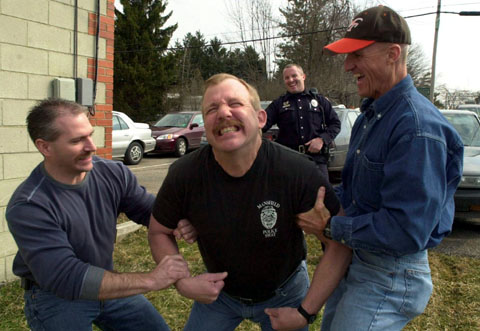
image above: Mansfiled Ohio Police Department has fun shooting each other with tasers. Sicko!
by David Morgan on 25 November 2007 in The CBS News "The danger of Tasers is that they seem safe, they seem easy and therefore I think it's natural that police will be inclined to use them much more quickly than they would ever use a gun." A United Nations committee said Friday that use of Taser weapons can be a form of torture, in violation of the U.N. Convention Against Torture. |
see also:
Island Breath: Police Militarization 5/7/08
Island Breath: KPD Overreact in Hanapepe 5/6/08
Island Breath: Protect and Serve - Not terrify! 4/5/08
Island Breath: Lingle Plan for Police State 9/22/07
